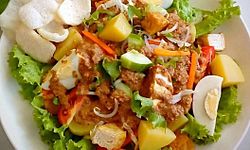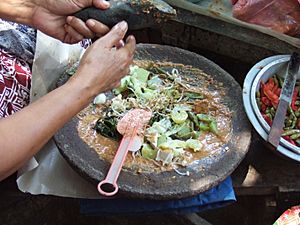Gado-gado facts for kids

Gado gado is vegetables mixed together with peanut sauce
|
|
| Course | Main course |
|---|---|
| Place of origin | Indonesia |
| Region or state | Jakarta |
| Associated national cuisine | Indonesia |
| Serving temperature | Room temperature |
| Main ingredients | Various vegetables in peanut sauce topped with krupuk |
| Variations | Karedok, a raw vegetable version of Gado-gado |
Gado-gado is a popular Indonesian salad. It is made with fresh, lightly cooked, or steamed vegetables. It also includes hard-boiled eggs, boiled potatoes, fried tofu, and tempeh. A special rice cake called lontong is often added. All these ingredients are served with a delicious peanut sauce dressing.
In 2018, gado-gado became one of Indonesia's five national dishes. The other national dishes are soto, sate, nasi goreng, and rendang.
Contents
What's in a Name? The Meaning of Gado-gado
The word gado or the verb menggado means to eat something without rice. So, Gado-gado literally means "mix-mix" in Indonesian. This name fits well because it's a mix of many different things!
It has lots of vegetables like potatoes, longbeans, bean sprouts, spinach, and cabbage. It also includes tofu, tempeh, and hard-boiled eggs. Everything is mixed with a rich peanut sauce. Sometimes, it's topped with crispy crackers called krupuk and fried shallots. Gado-gado is different from lotek atah or karedok, which use raw vegetables. Another similar dish is the Javanese pecel.
Where Gado-gado Comes From
Gado-gado is sold almost everywhere in Indonesia. Each area might have its own special way of making it. Many people think it first came from the Sundanese people. This is because it is most common in western parts of Java, including Jakarta and West Java.
The Javanese people have a similar dish called pecel. This dish is more common in Central and East Java. You can find gado-gado from street sellers, small food stalls called warung, and even in restaurants and hotels. It's also served in Indonesian restaurants around the world.
Even though it's called a salad, the peanut sauce is a very important part of gado-gado. The vegetables should be fully covered in the tasty sauce. Some places even add cashew nuts to the sauce for a richer flavor. In Jakarta, some restaurants are famous for their gado-gado. Some have been making it for decades and have many loyal customers. For example, Gado-Gado Boplo has been open since 1970.
The sauce is made from fried crushed peanuts, sweet palm sugar, garlic, chilies, salt, tamarind, and a squeeze of lime. Gado-gado is usually made fresh. Sometimes, it's made right in front of you! This way, you can choose how spicy you want it by adding more or less chili pepper. You can also find gado-gado sauce in a dried form. You just add hot water to it. Remember, gado-gado sauce is not the same as satay sauce, even though both are peanut sauces.
The Story of Gado-gado
The exact history of gado-gado is not fully known. There are a few different ideas about how this Indonesian dish began. Here are some of those theories:
The Word "Digado"
One idea is that gado-gado comes from the Indonesian word “digado.” This word is not in the main Indonesian dictionary. It comes from the Betawi language, spoken by the Betawi people. In Betawi, “digado” means "not eaten with rice." This is why gado-gado does not usually include rice. Instead, it uses lontong, which is a type of Indonesian rice cake.
From Tugu Village
Another idea is that gado-gado started in Tugu village. In the early 1700s, when Europeans came to Indonesia, some Portuguese people settled in what is now Tugu village. It is believed that these Portuguese people brought their local foods to Indonesia. Through their Portuguese culture, the dish gado-gado might have been introduced to Indonesia.
A Chinese Connection
Some people also believe that gado-gado came from the Chinese people living in Betawi. They say that Chinese people really liked the Javanese pecel, which is another Indonesian salad. They wanted to change the dish to better suit their own taste. This led to the creation of gado-gado.
Different Kinds of Gado-gado
There are several variations of gado-gado across Indonesia. Each one has its own special touch.
Gado-gado Betawi
This type of gado-gado comes from the Betawi area in Jakarta. It is known for being made in a slightly different way compared to other versions.
Gado-gado Padang
Unlike the simple gado-gado, gado-gado from Padang adds yellow noodles and sohun (clear cellophane noodles). This variation comes from Padang in West Sumatra. It is also known for its spicy flavor, just like many other dishes from Padang.
Gado-gado Sederhana
The name “gado-gado sederhana” means “simple gado-gado.” This is the basic way to prepare the dish. It uses vegetables, bean sprouts, lontong, and peanut sauce as its main ingredients.
Gado-gado Sidoarjo
This variation comes from Sidoarjo. It adds petis, which is a special food paste, to the peanut sauce.
Gado-gado Surabaya
In this version from Surabaya, the peanut sauce is cooked and then poured over the dish. Some people believe cooking the sauce helps the dish last longer. It often includes lettuce and tomatoes. Coconut milk is also added to the peanut sauce, making it look richer and taste even better.
What's in Gado-gado?
The Peanut Dressing
Most of the amazing flavors in gado-gado come from its bumbu kacang, or peanut salad dressing. Gado-gado tastes a little sweet, spicy, and savory all at once. The main ingredients for the peanut sauce are:
- Ground fried peanuts (sometimes kidney beans are used for a richer taste)
- Coconut sugar or palm sugar (you can use brown sugar if you don't have these)
- Chilies (add more or less depending on how spicy you like it)
- Terasi (a dried shrimp paste)
- Salt
- Tamarind juice
- Lime juice
- Water to make the sauce smooth
The traditional way to make gado-gado sauce is to use a cobek (a pestle) and ulekan (a flat rounded stone). First, the dry ingredients are ground. Then, the tamarind liquid is added until the sauce is just right.
The Vegetables
The vegetables in gado-gado can be different, but usually include a mix of these:
- Lightly cooked: Shredded, chopped, or sliced green vegetables like cabbage, kangkung, spinach, bean sprouts, young jack fruit, chayote, string bean, and corn.
- Sliced: Boiled potatoes.
- Fresh: Sliced cucumber, tomato, and lettuce.
- Other main ingredients: Peeled and sliced boiled eggs, and sliced fried tofu and tempeh.
Outside Indonesia, people often use whatever vegetables are available. Most ingredients are lightly cooked or blanched. The tempeh and tofu are fried, and cucumber is served fresh. All the cooked vegetables and other ingredients are mixed well with the peanut dressing.
Garnishes and Rice
In Indonesia, gado-gado is often served with chopped lontong or ketupat. These are special glutinous rice cakes. Sometimes, steamed rice is served separately. It almost always comes with krupuk, which are crispy crackers made from tapioca or melinjo. A common topping is bawang goreng, which is a sprinkle of finely chopped fried shallot.
How Gado-gado is Served
There are three main ways to enjoy gado-gado in Indonesia. First, many families make gado-gado at home. It's quite easy to prepare and cook, which is why it's a common dish in Indonesian households. Second, you can find gado-gado sold by street vendors and in small food stalls called warungs. Different cities might serve their own unique versions of gado-gado. Third, gado-gado is also a popular dish in restaurants that serve Indonesian food. It's a favorite because it's so well-loved across the country.
See also
 In Spanish: Gado-gado para niños
In Spanish: Gado-gado para niños



